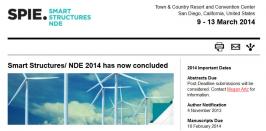Iman Talebinejad and Hassan Sedarat presented two papers at SPIE/Smart Structures NDE 2014 in San Diego, CA. SPIE is the international society for optics and photonics. The conference was held at the Town & Country Resort and Convention Center in San Diego on March 9-13, 2014.
The papers are available for purchase at the SPIE website.
Paper 1 (presented by Hassan)
“Real-Time Estimation of the Structural Response using Limited Measured Data”
Hassan Sedarat, Iman Talebinejad, Abbas Emami-Naeini, David Falck, Gwendolyn van der Linden, Farid Nobari, Alex Krimotat, SC Solutions, 1261 Oakmead Pkwy, Sunnyvale, CA 94085, USA
Jerome Lynch
University of Michigan, G. Brown Building, Ann Arbor, Michigan 48109-2125, USA
SPIE Smart Structures and Materials + Nondestructive Evaluation and Health Monitoring Nondestructive Characterization for Composite Materials, Aerospace Engineering, Civil Infrastructure, and Homeland Security 2014, edited by H. Felix Wu, Tzu-Yang Yu, Andrew L. Gyekenyesi, Aaron A. Diaz, Peter J. Shull, Proc. of SPIE Vol. 9063, 906311 • © 2014 SPIE
doi: 10.1117/12.2044617
Proc. of SPIE Vol. 9063 906311-1
ABSTRACT
This study introduces an efficient procedure to estimate the structural response of a suspension bridge in real-time based on a limited set of measured data. Unlike conventional techniques, the proposed procedure does not employ mode shapes and frequencies. In this study, the proposed technique is used to estimate the response of a suspension bridge structure based on a set of strain gauge measurements. Finite element analysis is performed only once to set up the structural parameters, namely computed flexibility matrix, and computed hanger forces matrix. The response of the bridge was estimated without any additional finite element analysis using the computed structural parameters and the measured hanger strains. The Alfred Zampa Memorial Bridge, on Interstate 80 in California, was selected for this study. A high fidelity finite element model of the bridge was developed using the general purpose computer program ADINA. The proposed method has been proven to have the capability to estimate any type of structural response in real time based on the measured hanger strains, and provides an important part of an integrated Structure Health Monitoring (SHM) system for major bridges.
Paper 2 (presented by Iman)
“Implementation of Damage Detection Algorithms for the Alfred Zampa Memorial Suspension Bridge”
I. Talebinejad, H. Sedarat, A. Emami-Naeini, A. Krimotat SC Solutions, Inc., 1261 Oakmead Parkway, Sunnyvale, CA 94087, USA
Jerome Lynch
Department of Civil and Environmental Engineering, University of Michigan 2380 G. G. Brown Building , University of Michigan, Ann Arbor, Michigan 48109-2125, USA
SPIE Smart Structures and Materials + Nondestructive Evaluation and Health Monitoring Nondestructive Characterization for Composite Materials, Aerospace Engineering, Civil Infrastructure, and Homeland Security 2014, edited by H. Felix Wu, Tzu-Yang Yu, Andrew L. Gyekenyesi, Aaron A. Diaz, Peter J. Shull, Proc. of SPIE Vol. 9063, 906312 • © 2014 SPIE
doi: 10.1117/12.2044539
Proc. of SPIE Vol. 9063 906312-1
ABSTRACT
This study investigated a number of different damage detection algorithms for structural health monitoring of a typical suspension bridge. The Alfred Zampa Memorial Bridge, a part of the Interstate 80 in California, was selected for this study. The focus was to implement and validate simple damage detection algorithms for structural health monitoring of complex bridges. Accordingly, the numerical analysis involved development of a high fidelity finite element model of the bridge in order to simulate various structural damage scenarios. The finite element model of the bridge was validated based on the experimental modal properties. A number of damage scenarios were simulated by changing the stiffness of different bridge components including suspenders, main cable, bulkheads and deck. Several vibration-based damage detection methods namely the change in the stiffness, change in the flexibility, change in the uniform load surface and change in the uniform load surface curvature were employed to locate the simulated damages. The investigation here provides the relative merits and shortcomings of these methods when applied to long span suspension bridges. It also shows the applicability of these methods to locate the decay in the structure.
